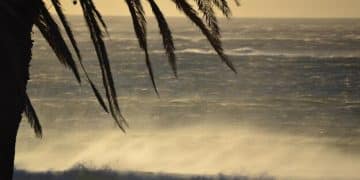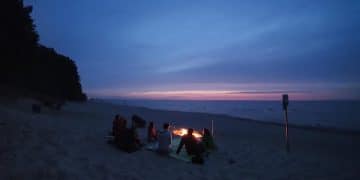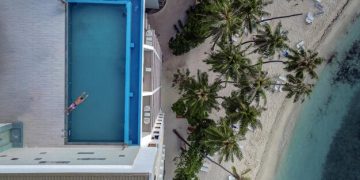Beach Camping 101: Essential Tips & Eco-Friendly Guide
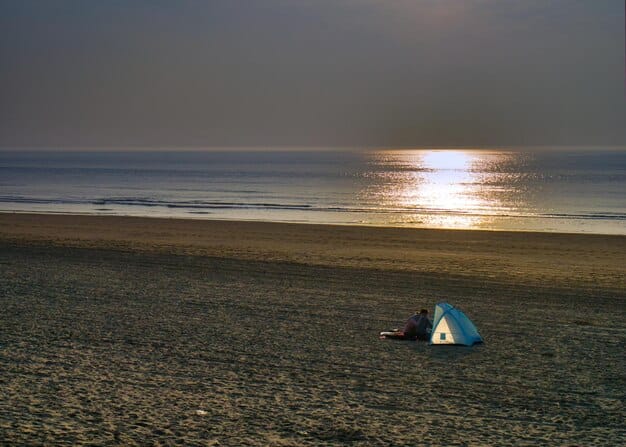
Mastering Beach Camping 101: Essential Tips for a Comfortable and Eco-Friendly Trip involves understanding proper equipment, environmental stewardship, and safety protocols to ensure a memorable and sustainable outdoor experience by the sea.
Dreaming of waking up to the sound of crashing waves, with salty air filling your lungs and sand between your toes? Beach Camping 101: Essential Tips for a Comfortable and Eco-Friendly Trip offers an unparalleled escape from the mundane, merging the tranquility of the seaside with the adventure of the outdoors. This guide will help you navigate the nuances of camping on the sand, ensuring both your comfort and the preservation of our precious coastal ecosystems.
Planning Your Beach Camping Adventure: Permits and Preparation
Beach camping, while deeply appealing, requires a meticulous planning phase that extends beyond simply packing a tent. The unique environment of a beach presents distinct challenges and regulations not typically encountered in a forest or mountain setting. Understanding these prerequisites is fundamental to a successful and respectful outing. It’s not just about finding a spot; it’s about navigating the legal landscape and preparing for specific conditions.
The first, and arguably most important, step is securing the necessary permits. Unlike many traditional campsites, beach camping often takes place in protected areas, state parks, or reserves that have strict rules to mitigate environmental impact and ensure public safety. Failing to acquire a permit can lead to hefty fines, eviction, and even jeopardize future access to these beautiful locations. Research local regulations well in advance of your trip. Websites for state parks, national seashores, or local government tourism boards are usually the best places to start your inquiry. Some popular beach camping spots require reservations months in advance, especially during peak seasons, so early planning is non-negotiable. Always verify the exact dates your permit is valid for and carry a printed or digital copy with you.
Beyond permits, preparing for the specific conditions of a beach environment is crucial. The sand, wind, and saltwater can be surprisingly harsh on gear and demanding on campers. Consider the tidal patterns; camping too close to the high tide line can result in a rude awakening as waves encroach on your sleeping area. Consult local tide charts and understand the moon phases, which significantly influence tidal range. Furthermore, sunlight on a beach can be intense, with reflections off the water and sand amplifying UV exposure. Packing adequate sun protection—high SPF sunscreen, wide-brimmed hats, and UV-protective clothing—is as important as bringing your tent. Hydration is another key factor. Salty air and hot sun can lead to quicker dehydration, so bring plenty of potable water, far more than you think you will need.
Finally, think about the unique challenges of sand. Sand gets everywhere, into gear, food, and even sleeping bags. While it’s part of the experience, minimizing its intrusion can greatly enhance comfort. Consider gear designed for sandy environments, and have a strategy for cleaning items before packing them away. A small brush or dustpan can be surprisingly useful. The wind can also be a formidable adversary; pitching a tent securely requires more than just standard stakes. Utilizing sand anchors or burying large objects for extra support can prevent your shelter from becoming dislodged in strong gusts. Adequate preparation ensures that the beauty of the beach isn’t overshadowed by avoidable discomforts or regulatory issues, making your outdoor retreat truly relaxing and memorable.
Essential Gear for a Comfortable Beach Camp
Achieving comfort while beach camping hinges significantly on the gear you choose. The unique environmental factors of coastal areas—namely sand, wind, and saltwater—demand specific considerations beyond what might suffice for a typical forest camping trip. Investing in or borrowing the right equipment can transform a potentially challenging experience into a genuinely comfortable and enjoyable one. Thoughtful selection ensures durability, functionality, and peace of mind.
Selecting the Right Tent and Sleeping System
The cornerstone of any comfortable camping trip is a reliable shelter, and for beach camping, this means a tent designed to withstand specific conditions. Look for tents with a robust, aerodynamic design that can shed strong winds. Many standard tents struggle against persistent coastal breezes, leading to bent poles or flapping fabric. Furthermore, opt for tents with ample ventilation to counter the often warm and humid beach climate. Mesh windows and doors are crucial for airflow, helping to prevent condensation and keep the interior cool. Another vital feature is a bathtub-style floor that extends several inches up the sidewalls; this design helps keep sand from blowing into the tent and offers better protection against potential moisture.
When it comes to your sleeping system, traditional sleeping pads and bags may not be ideal. The fine grains of sand can easily infiltrate fabrics, making them gritty and uncomfortable.
- Sleeping Pad: Consider a self-inflating sleeping pad with a durable, easily washable surface. Air mattresses can also provide excellent insulation from the ground and superior comfort.
- Sleeping Bag: Even in warm climates, nights can get cool, especially with ocean breezes. A lightweight sleeping bag with a temperature rating appropriate for coastal nights is advisable. Alternatively, a comfortable sleep sack or even just a sheet and blanket might suffice in very warm conditions.
- Ground Cover: Always use a sturdy tarp or ground cloth beneath your tent. This layer adds an extra barrier against sand, moisture, and potential punctures, extending the life of your tent floor.
Cooking and Hydration Solutions
Preparing meals and staying hydrated are fundamental to any camping trip, but beach environments present their own set of challenges. Sand and wind can easily contaminate food or make cooking difficult.
The wind poses a significant challenge for cooking on a beach. Portable camp stoves are viable, but they require wind screens to maintain a consistent flame. Without one, you’ll waste fuel and struggle to heat anything efficiently. Pack extra fuel as a precaution. Opt for simple, one-pot meals to minimize dishes and reduce the chance of sand contamination. Pre-chopped ingredients can save time and effort. Beyond cooking, managing water is paramount. Access to potable water is often limited on beaches, so bringing your own supply is non-negotiable.
- Water Storage: Large, durable water containers or collapsible water bladders are essential. Aim for at least one gallon of water per person per day for drinking, cooking, and light washing.
- Water Filter/Purifier: While not a substitute for bringing ample water, a reliable water filter or purification tablets can be a lifesaver in an emergency or for extending your supply if you find a freshwater source.
- Cooler: A high-quality cooler is invaluable for keeping food fresh and drinks cold in the warm beach environment. Consider a sturdy, rotomolded cooler that can withstand rough treatment and provides superior insulation.
- Kitchen Essentials: Don’t forget biodegradable soap, a scrubber, and a designated wash basin for dishes. Always dispose of greywater responsibly, away from the ocean and any freshwater sources.
Comfort Enhancements and Safety Items
Beyond the basics, several items can significantly enhance your beach camping comfort and safety. From creating a more pleasant lounging area to being prepared for unexpected situations, these additions are well worth the space they take.
Think about how you’ll relax and enjoy the beach beyond just sleeping. Portable beach chairs or hammocks, especially those designed for sandy use, can create comfortable spots for reading or watching the waves. A large beach blanket or a sand-free mat provides a clean area for lounging. For lighting, lanterns with varying brightness settings are useful, as are headlamps for hands-free navigation in the dark. A portable power bank can keep devices charged, important for navigation or emergencies where phone access might be critical.
Safety on the beach includes protection from the elements, as well as being prepared for emergencies.
- First-Aid Kit: A comprehensive kit is non-negotiable. Include items for cuts, scrapes, stings (jellyfish/insect repellent), sunburns, and any personal medications.
- Weather Protection: Beyond sun protection, consider a lightweight rain jacket and pants, even if the forecast looks clear. Coastal weather can change rapidly.
- Communication: A fully charged cell phone is important, but also consider a satellite messenger or personal locator beacon if you’re in a remote area with spotty service.
- Navigation: A physical map and compass, along with a GPS device or app, are crucial, especially if exploring dunes or less-traveled areas.
- Portable Shovel: Surprisingly useful for digging out tent anchors, creating windbreaks, or even for emergency sanitation needs.
By prioritizing thoughtful gear selection, you can transform your beach camping experience from merely tolerable to exceptionally comfortable and safe. The right equipment is an investment in your enjoyment and ability to truly connect with the coastal environment.
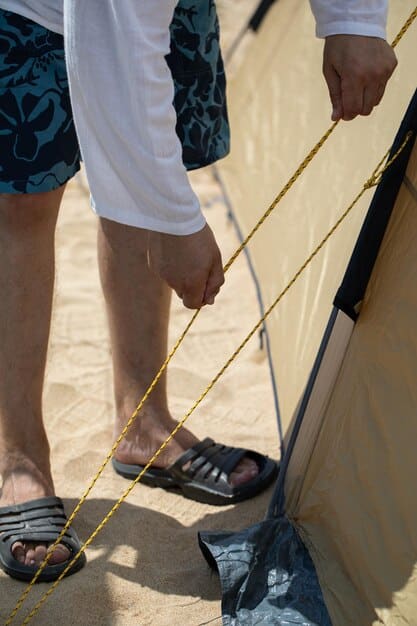
Eco-Friendly Beach Camping: Leave No Trace Principles
Embracing the “Leave No Trace” principles is more than just a guideline; it’s a fundamental responsibility when engaging with any natural environment, especially coastal ecosystems. Beaches are fragile habitats, home to unique flora and fauna, and are constantly shaped by natural processes. Our presence, no matter how brief, can have lasting impacts if not managed conscientiously. Adhering to these principles ensures that the beauty and ecological integrity of the beach remain preserved for future generations, fostering a sustainable relationship between humans and nature.
The core of Leave No Trace revolves around minimizing human impact. This means planning ahead and preparing, traveling and camping on durable surfaces, disposing of waste properly, leaving what you find, minimizing campfire impacts, respecting wildlife, and being considerate of other visitors. Each principle addresses a specific aspect of outdoor ethics, aiming to leave the environment as undisturbed as possible. For beach camping, these principles often take on specific nuances, requiring tailored approaches to be effective.
One of the most visible impacts on beaches is waste. Everything from food scraps to plastic packaging can easily be carried into the ocean by winds or tides, harming marine life and polluting waters. Therefore, packing out everything you pack in is non-negotiable. This includes all food waste, even seemingly biodegradable items like fruit peels, which can take a long time to decompose in sandy, saline environments and can attract wildlife. Carry designated waste bags, and consider bringing an extra bag for any litter you might encounter from previous visitors.
Respecting Wildlife and Their Habitats
Beaches are vibrant ecosystems, serving as crucial breeding and feeding grounds for a variety of species, from shorebirds to sea turtles. Our activities can inadvertently disrupt their lives, sometimes with devastating consequences.
Minimizing disturbance to wildlife is paramount. Keep a respectful distance from all animals, and never attempt to feed them. Human food can be harmful to animals and can lead to them becoming dependent on human handouts, altering their natural foraging behaviors. Be especially vigilant during nesting seasons for birds and sea turtles, often marked by signs or roped-off areas. Many species nest directly on the sand, and disturbing their nests can lead to abandonment or destruction of eggs. This means being mindful of where you walk, pitch your tent, and set up your recreational areas.
- Observe from Afar: Use binoculars to watch animals instead of approaching them.
- Secure Food: Store all food and scented items in sealed containers to prevent attracting scavengers.
- Light Discipline: Minimize light pollution, especially at night. Artificial lights can disorient nocturnal animals like sea turtle hatchlings, leading them away from the ocean.
Minimizing Campfire Impact and Waste Management
Campfires are synonymous with camping, but on beaches, they require extra caution due to the risk of wildfires and the environmental impact of burnt debris.
Many beaches prohibit campfires altogether due to the risk of fire spreading to dry dunes or vegetation, or simply due to the difficulty of cleaning up ashes and charcoal from the sand. Always check local regulations regarding campfires. If fires are permitted, use only established fire rings or bring a portable fire pan to contain ashes and embers. Collect only dead and downed wood that is smaller than your wrist to burn, and never cut live trees or shrubs. Ensure fires are completely extinguished with water and cold to the touch before leaving, and pack out all charcoal and unburnt wood. Leaving behind scorched sand or partially burnt wood ruins the natural aesthetic for others and impacts the ecosystem.
Proper waste management extends beyond solid waste to include human waste and greywater. Dig catholes at least 200 feet (approximately 70 steps) away from water sources, trails, and campsites for solid human waste, and bury it completely. Pack out all toilet paper. For greywater from washing dishes or showering, collect it in a basin and dispose of it far from water sources, distributing it widely to minimize concentration in one area. Use biodegradable soaps sparingly, if at all.
- Pack It In, Pack It Out: This golden rule applies to everything, including food scraps, packaging, and personal hygiene products. Leave nothing behind.
- Dispose of Waste Properly: Use designated receptacles where available, or pack out all trash, including small items like bottle caps and cigarette butts.
- Leave What You Find: Resist the urge to collect shells, rocks, or other natural objects. Leave them for others to enjoy and for the natural ecosystem.
Adhering to these eco-friendly practices allows you to fully enjoy the unique beauty of beach camping while ensuring that these incredible natural spaces remain vibrant and healthy for generations to come. It’s a commitment to be a responsible steward of the environment.
Safety First: Navigating Beach Environment Challenges
Beach environments, while offering unparalleled beauty and serenity, present a distinct set of safety challenges that campers must be acutely aware of. Unlike traditional forest or mountain camping, the open, dynamic nature of a beach exposes campers to specific risks related to sun, water, and sand, as well as unique wildlife encounters. Prioritizing safety through proactive measures and informed decision-making is essential for a worry-free and enjoyable beach camping experience. It’s not just about what you bring, but how you interact with the environment around you.
One of the most significant environmental hazards on a beach is the sun. The combination of direct sunlight, reflective sand, and water glare can lead to rapid and severe sunburn, heatstroke, and dehydration. Sun protection should be a top priority from the moment you arrive until you depart. This means diligently applying high-SPF, broad-spectrum sunscreen frequently, even on cloudy days. Wearing wide-brimmed hats and UV-protective clothing provides additional layers of defense. Seek shade during peak sun hours (typically 10 AM to 4 PM) whenever possible. Staying well-hydrated by consistently drinking water is equally important to mitigate the risks of heat-related illnesses. Recognizing the symptoms of heat exhaustion and heatstroke early is crucial for prompt intervention.
The ocean itself, while inviting, poses numerous dangers. Rip currents are a primary concern, capable of sweeping even strong swimmers out to sea. Familiarize yourself with how to identify a rip current and, more importantly, how to escape one (swim parallel to the shore, not against the current). Always swim with a buddy and never swim under the influence of alcohol. Be aware of tidal changes; incoming tides can quickly engulf equipment or cut off access to certain areas, particularly on sandbars or narrow stretches of beach. Check local tide charts and set up camp well above the high tide mark. Additionally, marine life, such as jellyfish, stingrays, or even sharks, can be present. Be aware of local advisories and learn how to identify potential hazards and treat common stings or bites.
Coastal Weather Preparedness
Coastal weather can be highly unpredictable, changing rapidly from clear skies to powerful storms. Being prepared for sudden shifts is vital for safety.
Strong winds are a common occurrence on beaches and can cause significant problems for campers. High winds can easily destroy tents, blow away gear, and make cooking impossible. Before setting up, evaluate the wind direction and strength. Angle your tent to present the smallest profile to the wind, and use heavy-duty sand stakes or burry objects like rocks or driftwood to secure your tent thoroughly. A tent designed for wind resistance is a worthwhile investment. Keep all loose items secured or stored inside to prevent them from being blown away or into the ocean.
Sudden thunderstorms, squalls, or even tropical depressions can develop quickly near the coast. Monitor weather forecasts meticulously before and during your trip using reliable sources. Do not hesitate to pack up and evacuate to a safer location if severe weather is predicted. Lightning strikes are a significant risk on open beaches; if a thunderstorm approaches, seek shelter immediately in a car or substantial building, avoiding open areas, tall objects, and the water. Heavy rain can also lead to flash floods in some coastal areas, especially near estuaries or low-lying zones, so situational awareness is key.
- Monitor Forecasts: Regularly check local weather and tidal predictions.
- Secure Shelter: Use proper anchoring techniques for tents to withstand strong winds.
- Emergency Exit Plan: Know escape routes and designated safe zones in case of severe weather.
Responsible Wildlife Encounters and Site Selection
While it’s thrilling to share coastal spaces with wildlife, interactions should always prioritize both human and animal safety. Proper food storage and site selection are key to preventing unwanted encounters.
Animals are naturally drawn to food sources, and your campsite can become an irresistible target for scavengers, from raccoons and foxes to birds and even larger predators in some remote areas. Store all food and scented items in animal-proof containers or locked in your vehicle/cooler. Never leave food unattended, and always clean up spills and crumbs immediately. Dispose of all trash in secure, animal-proof bins or pack it out. This prevents animals from becoming habituated to human food, which can lead to aggressive behavior or their eventual demise.
Selecting an appropriate camping site not only enhances comfort but also plays a critical role in safety. Avoid setting up camp in low-lying areas that might flood with high tides or heavy rain. Steer clear of unstable cliffs or bluffs that could be prone to erosion or collapse. Look for firm, level ground away from any potential hazards. Be mindful of plant life, particularly thorny bushes or poison ivy/oak, which can be found in coastal dunes. By respecting wildlife and choosing your campsite wisely, you minimize risks and ensure a more harmonious coexistence with the natural environment.
- Secure Food: Use bear-proof canisters or keep food in your vehicle to deter animals.
- Check for Hazards: Inspect your chosen campsite for sharp objects, marine debris, or unstable ground.
- Awareness and Respect: Never approach or harass wildlife. Maintain a safe distance.
By thoughtfully addressing these safety considerations, you transform your beach camping experience into a secure and enriching adventure, allowing you to fully appreciate the unique beauty of the coast without undue concern.
Cooking and Eating on the Sand: Practical Tips
Cooking and eating on a sandy beach present a unique set of challenges that can either be a source of frustration or an opportunity for creative problem-solving. Unlike solid ground, sand has a knack for getting everywhere, and the constant wind can make open-flame cooking incredibly difficult. Mastering the art of beachside gastronomy requires thoughtful planning, specialized equipment, and a flexible mindset to enjoy delicious meals against a backdrop of sun and surf.
The pervasive nature of sand is arguably the biggest hurdle. It cling to everything: your food, your utensils, and even your teeth. The key strategy here is prevention. Designate a specific “kitchen” area that is as sheltered from the wind as possible, perhaps behind a vehicle or a natural dune if permissible. Lay down a large tarp or ground mat as a clean, sand-free surface for food preparation and cooking. This creates a barrier between your ingredients and the omnipresent grains, making cleanup significantly easier. For food storage, use sealed, sturdy containers rather than flimsy bags that can tear and allow sand in.
Wind is another major adversary, particularly for propane or traditional camp stoves. A simple gust can extinguish a flame, waste fuel, and prolong cooking times. A good quality wind screen for your stove is not optional; it’s essential. Many portable stoves come with integrated screens, or you can purchase a collapsible one. Positioning your stove strategically, facing away from the prevailing wind, further helps maintain a steady flame. Consider also the type of fuel and stove. A liquid fuel stove often performs better in windy conditions than a canister stove, though both require proper wind shielding. Some campers even opt for a small charcoal grill or a portable fire pit (if allowed and safe) where heat is less susceptible to wind interference.
Meal Planning for Sandy Conditions
Strategic meal planning can greatly simplify beach cooking, reducing complexity and potential for sand contamination.
Focus on menus that are simple, require minimal ingredients, and generate little waste. Think one-pot meals, pre-marinated meats or vegetables for grilling, and dishes that don’t necessitate extensive chopping or numerous cooking steps. Pre-prepare as much as possible at home: wash and chop vegetables, portion out ingredients, and mix dry spices. This reduces mess and minimizes exposure to wind and sand at your campsite. Foods that can be cooked and eaten with minimal fuss, like hot dogs, skewers, or foil-packet meals, are ideal. These also minimize dishwashing afterwards, which is another beachside challenge.
For eating, use durable, reusable plates, cups, and utensils that are easy to wash. Avoid single-use plastic whenever possible to reduce waste. A designated wash basin, biodegradable soap, and plenty of water are crucial for dish clean-up. Remember to dispose of greywater (from washing dishes) far from the ocean and any freshwater sources, distributing it widely across the sand.
- Pre-Prep at Home: Chop veggies, mix sauces, and portion ingredients to minimize beachfront efforts.
- One-Pot Wonders: Choose recipes that require fewer dishes and less intricate cooking.
- Sealed Containers: Use airtight containers for all food items to prevent sand intrusion.
Keeping Food Fresh and Hydration
Maintaining food safety and staying hydrated in the warm beach environment requires diligent attention.
A high-quality cooler with excellent insulation is indispensable for keeping perishable foods and drinks cold amidst sandy conditions and warm temperatures. Pre-chill your cooler with ice or ice packs the day before your trip. Use block ice or frozen water bottles, which last longer than क्यूबd ice, and pack items densely to minimize air pockets. Keep the cooler shaded and open it only when necessary to retain coldness. Separate raw meats from other foods to prevent cross-contamination.
Hydration is critical. The combination of sun, heat, and activity on the beach can lead to rapid dehydration. Bring significantly more potable water than you think you will need – at least a gallon per person per day for drinking, cooking, and light washing. Consider bringing a separate cooler just for drinks to minimize opening your food cooler. Electrolyte tablets or powders can also be beneficial in preventing dehydration-related fatigue. By addressing these practicalities, you transform beach cooking from a chore into a delightful part of your coastal adventure, ensuring delicious and safe meals by the sea.
Weathering the Elements: Wind, Sun, and Tides
Beach camping exposes you directly to the raw power of the elements: relentless wind, intense sun, and the ever-changing tides. Unlike other camping environments, there’s often little natural shelter, making strategic preparation for these forces paramount to both comfort and safety. Ignoring these elemental realities can quickly turn a dream trip into a miserable ordeal, emphasizing the need for proactive measures and understanding the beach’s dynamic nature.
Wind is perhaps the most constant companion on a beach, often strong and unyielding. It can turn a calm setting into a chaotic scene in minutes, making activities like cooking difficult and threatening the structural integrity of your tent. Selecting a tent designed with a low profile and strong, flexible poles is foundational. Many standard tents are not engineered for sustained high winds and can quickly collapse or tear. The way you pitch your tent is equally critical; always orient the narrowest side of your tent into the prevailing wind to reduce resistance. Beyond the tent, securing everything else is vital. Chairs, towels, food wrappers, and even small cooking pots can become airborne projectiles in a strong gust. Use heavy-duty stakes (like snow or sand stakes) for your tent and secure all loose gear, either by tying it down, weighing it with rocks, or storing it inside your vehicle or sturdy containers.
The sun on a beach, amplified by reflection off the sand and water, can be deceptively intense, leading to sunburn and heatstroke even on seemingly mild days. Continuous exposure to UV radiation also poses long-term health risks. Comprehensive sun protection is non-negotiable. This means not just sunscreen, but also wearing wide-brimmed hats, sunglasses with UV protection, and lightweight, long-sleeved clothing. Creating shade at your campsite is also important. A sturdy beach umbrella or a portable canopy can provide a much-needed respite from the direct sun, allowing you to relax without constant exposure. These shelters also protect your gear from overheating and direct UV damage.
Understanding and Respecting Tides
The ocean’s tides are a powerful, predictable force that can dramatically alter the beach landscape. Misjudging them can lead to flooded tents or cut-off escape routes.
Understanding tidal patterns is arguably the most crucial aspect of beach safety. Consult local tide charts before you arrive and check them daily. The two most significant factors are the high tide line and tidal range. Always pitch your tent well above the high tide mark, accounting for spring tides (exceptionally high tides that occur during full and new moons) and storm surges, which can push water even further inland. A good rule of thumb is to set up where the highest tideline has clearly not reached recently, looking for dry, undisturbed sand.
Be especially cautious of camping on sandbars or low-lying areas that can become isolated or submerged during high tide. An area that seems perfectly dry and safe during low tide can become an impassable channel within hours. If you plan to explore, be aware of the tides, and how they might affect your return path. Teach children about tide safety and ensure they understand the ever-changing nature of the waterline.
- Check Tide Charts: Always consult local tide schedules and understand the high and low tide times.
- Camp Above High Water Mark: Pitch your tent well away from the maximum reach of the tide.
- Monitor Water Levels: Be aware of the incoming and outgoing tides throughout your stay, especially during the night.
Protecting Gear from Sand and Saltwater
Sand and saltwater are corrosive and abrasive, posing a constant threat to your valuable camping gear. Proactive protection is key to longevity.
Fine sand particles can work their way into zippers, electronics, and camera lenses, causing damage and malfunction. Saltwater is highly corrosive to metals and can leave damaging residues on fabrics. When packing, use dry bags or waterproof stuff sacks for clothes, electronics, and anything sensitive to moisture. Keep zippers clean and free of sand; a small brush or dedicated zipper cleaner can be invaluable. Rinse gear exposed to saltwater with fresh water as soon as possible after use to prevent corrosion.
Always try to keep gear off the sand when not in use. Use a ground tarp inside your tent for a cleaner floor, and place items on mats or in mesh bags. When packing up, shake out everything thoroughly to remove as much sand as possible before placing it in your car or storage. A small, portable broom or dustbuster can be surprisingly useful for this. By diligently protecting your gear, you ensure its longevity and maintain its functionality for future adventures, making your beach camping experience significantly smoother and more enjoyable.

Troubleshooting Common Beach Camping Issues
Even with meticulous planning, beach camping often throws unique curveballs. From sand infiltrating every crevice to unexpected weather shifts, encountering and effectively troubleshooting common issues can be the difference between a frustrating trip and a resilient adventure. Being prepared with solutions and a flexible mindset allows you to overcome hurdles and still enjoy the unique beauty of the coast.
One of the most persistent complaints for beach campers is the omnipresent sand. It doesn’t just stick to your feet; it finds its way into sleeping bags, electronics, food, and every piece of gear. The best defense is a layered approach. Outside your tent, create a “sand-free zone” where you remove shoes and outerwear before entering. A small, stiff brush or a damp cloth at the tent entrance can help wipe down feet and gear. Inside the tent, a breathable mat or tarp can serve as an additional barrier, trapping stray sand. For electronics, use sealed waterproof bags or cases when not in use. When packing up, shake out every item thoroughly and use a dustpan and broom or portable vacuum to clean the tent interior before stowing.
Dealing with wind can be another significant challenge. Whether it’s flapping tents, blown-away gear, or difficulty cooking, wind can disrupt your entire campsite. If your tent is struggling, reinforce your stakes with larger sand anchors or by burying objects like driftwood or rocks for extra hold. Adjust guy lines to be taut and evenly distributed. For cooking, ensure your stove has a robust wind screen. If the wind is truly relentless, consider cooking simple, no-cook meals or heading to a more sheltered spot temporarily. Always secure everything that could blow away, from empty bags to small utensils, immediately upon arrival.
Humidity, Condensation, and Salt
The coastal environment’s high humidity and saline air can cause unique problems for gear and comfort.
High humidity often leads to condensation inside tents, even when temperatures are mild. This can make sleeping bags damp and uncomfortable. To combat condensation, maximize tent ventilation by keeping all vents open and unzipping windows and doors whenever possible, especially if there’s a breeze. Ensure your tent has good airflow. If possible, air out your sleeping bag and clothes during sunny periods. Using a sleeping bag liner can also help keep your main bag dry and clean.
Salt, carried by the air and water, can corrode metal parts, clog zippers, and leave a sticky residue on surfaces. After your trip, clean all gear thoroughly. Rinse tent poles, zippers, and any metal components with fresh water, and allow them to dry completely before storage. Lubricate zippers designed for marine environments if needed. For electronics, keep them in sealed bags when not in use, and use desiccant packets (silica gel) to absorb moisture. Regular cleaning and proper storage are crucial for extending the lifespan of your gear in a salty environment.
- Ventilate Tent: Keep tent vents and windows open to minimize condensation.
- Rinse Gear After Trip: Wash off salt residue from all equipment with fresh water.
- Use Desiccants: Place silica gel packets with electronics to absorb moisture.
Emergencies and Unexpected Events
Despite best efforts, unexpected emergencies can arise. Preparedness and a calm approach are key to managing these situations.
Minor injuries like cuts from shells, scrapes, or severe sunburns are common. A well-stocked first-aid kit is essential. It should include bandages, antiseptic wipes, pain relievers, blister treatment, and specific remedies for insect bites or jellyfish stings (like vinegar or hot water). For more serious medical emergencies, know how to contact local emergency services and be aware of your exact location to provide accurate directions. A satellite messenger or fully charged power bank for your cell phone can be critical in areas with poor reception.
Unexpected weather shifts, particularly sudden storms or high winds, demand immediate action. Monitor forecasts continuously. If severe weather is imminent, pack up immediately. If evacuation isn’t possible, secure your tent as best as you can, and seek shelter in a vehicle. For a full-blown emergency, have an evacuation plan in place, identifying safe routes away from the beach. Always inform someone of your itinerary and expected return time. By anticipating potential issues and having solutions ready, you can transform challenges into learning experiences, ensuring your beach camping trip remains a positive and memorable encounter with nature.
| Key Point | Brief Description |
|---|---|
| 🌊 Permits & Prep | Secure permits, check tides, and pack for sun/sand. |
| 🏕️ Essential Gear | Wind-resistant tent, sand anchors, reliable cooler, and ample water. |
| ♻️ Leave No Trace | Pack out all waste, respect wildlife, and minimize campfire impact. |
| 🩹 Safety First | Sun protection, rip current awareness, and emergency kit are crucial. |
Frequently Asked Questions About Beach Camping
▼
The most crucial items include a wind-resistant tent with sand stakes, a high-quality cooler, ample potable water, strong sun protection (sunscreen, hats, UV clothing), and a comprehensive first-aid kit. Additionally, consider a portable wind screen for cooking and dry bags for electronics to protect against sand and moisture.
▼
To protect your tent, use specialized sand stakes or bury large objects like rocks for extra anchorage. Orient the narrowest side of your tent into the prevailing wind to reduce resistance. Ensure all guy lines are taut and properly secured. Choosing a low-profile, aerodynamic tent designed for harsh conditions provides added durability against gusts.
▼
Eco-friendly practices include strictly adhering to Leave No Trace principles: pack out all trash (even food scraps), camp on durable surfaces above the high tide line, minimize campfire impact (if allowed), and respect wildlife by keeping a distance and securing food. Avoid disturbing natural vegetation or collecting shells/rocks.
▼
Set up a “sand-free zone” outside your tent where shoes/gear are removed. Use a ground sheet both under and inside your tent. Keep bags zippered and store sensitive items in waterproof, sealed containers. Shake out items thoroughly before packing them away. A small broom or dustpan can be useful for tent clean-up.
▼
Primary safety concerns include sunburn and heatstroke from intense sun, rip currents and tidal shifts in the ocean, strong winds, and potential encounters with marine wildlife or insects. Always check tide charts, use ample sun protection, swim with a buddy, secure your camp, and monitor weather forecasts closely for sudden changes.
Conclusion
Beach camping offers a unique blend of adventure and serene escape, but successfully navigating this distinct environment hinges on forethought and a commitment to responsible practices. From meticulously planning permits and selecting gear resilient to sand and wind, to vigilantly observing Leave No Trace principles and prioritizing safety, every step contributes to a memorable and sustainable experience. By respecting the delicate coastal ecosystem and preparing for its unique challenges, you can enjoy the unparalleled beauty of waking up to the ocean’s rhythm, leaving nothing but footprints behind.
